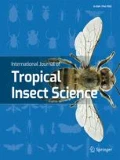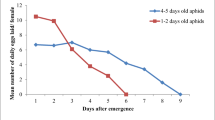Abstract
The use of pesticides may pose a serious threat to soil and water quality, human health, food safety, aquatic species and beneficial insects. Biological control is an effective component of integrated pest management comprising importation, augmentation and conservation. Conservation of natural enemies could enhance or limit the efficiency of herbivorous insect pests. The present study was designed to evaluate the efficiency of Diaeretiella rapae (McIntosh) and other food resources impacts on parasitoid’s fecundity, survival and efficiency. The effect of different insecticides [Carbosulfan, Imidacloprid, Diafenthiuron and Lufenuron] was also evaluated in a laboratory controlled experiment. The results revealed that females fed on aphid honeydew proved to be of poor quality as compared to other sugar sources, including honey and sugar solution and has a positive impact of mating on monogenesis. The negative impact was observed on oviposition activity by female reared in the laboratory having less number of mature eggs than females collected in the field. All insecticides demonstrated dose-dependent mortality of D. rapae. In conclusion, food and host availability and insecticides affect the efficiency of D. rapae. These results could lead to the hypothesis that D. rapae females have a high mortality rate in the field due to lower aphid hosts.












source dependent parasitism (%) of cabbage aphid by D. rapae in term of mummification of aphids after different exposure intervals (days)
Similar content being viewed by others
Availability of data and materials
The datasets used and/or analyzed during the current study are available from the corresponding author on reasonable request.
Abbreviations
- GM:
-
Genetically modified
- FAO:
-
Food and agriculture organization
- USDA:
-
United States Department of Agriculture
- RH:
-
Relative humidity
- LD:
-
Light day
- ANOVA:
-
Analysis of variance
- IPM:
-
Integrated pest management
References
Abdulle YA, Nazir T, Keerio AU, Ali H, Zaman S, Anwar T, Nam TD, Qiu D. (2020) In vitro virulence of three Lecanicillium lecanii strains against the whitefly, Bemisia tabaci (Genn.)(Hemiptera: Aleyrodidae). Egypt J Biol Pest Control 30(1):1-6.
Ahmad M, Akhtar S (2013) Development of insecticide resistance in field populations of Brevicoryne brassicae (Hemiptera: Aphididae) in Pakistan. J Econ Entomol 106:954–958
Ali H, Qasim M, Saqib HS, Arif M, Islam SU (2015) Synergetic effects of various plant extracts as bio-pesticide against wheat aphid (Diurophous noxia L.)(Hemiptera: Aphididae). Afr J Agric Sci Technol 7:310–315
Altieri MA (1995) Abundance, growth rate and parasitism of Brevicoryne brassicae and Myzus persicae (Homoptera: Aphididae) on broccoli grown in living mulches. Agric Ecosyst Environ 52:187–196
Amarasekare P, Savage V (2012) A framework for elucidating the temperature dependence of fitness. Am Nat 179:178–191
Amini B, Madadi H, Desneux N, Lotfalizadeh HA (2012) Impact of Irrigation Systems on Seasonal Occurrence of Brevicoryne brassicae and Its Parasitism by Diaeretiella rapae on Canola. J Entomol Res Soc 14(2):15–26
Anonymous (2013) Economic survey of Pakistan. Min Fin Isb Pak pp. 22
Borgemeister C, Poehling HM, Dinter A, Holler C (1993) Entomophaga 38:245–255
Burger JM, Reijnen TM, Van Lenteren JC, Vet LE (2004) Host feeding in insect parasitoids: why destructively feed upon a host that excretes an alternative? Entomol Exp Appl 112(3):207–215
Croft BA (1990) Arthropods biological control agents and pesticides. Jhon Wiley and Sons, New York
Dhaliwal GS, Jindal V, Dhawan AK (2010) Insect pest problems and crop losses: changing trends. Indian J Ecol 37(1):1–7
Dhaliwal GS, Koul O (2010) Quest for pest management: from green revolution to gene revolution. Kalyani Publishers
Fadamiro HY, Chen L, Onagbola EO, Graham LF (2005) Lifespan and patterns of accumulation and mobilization of nutrients in the sugar-fed phorid fly Pseudacteon tricuspis. Physiol Entomol 30:212–224
Farid A, Johnson JB, Shaft B, Quisenbery SS (1998) Tritrophic studies of Russian wheat aphid a parasitoid and resistant and susceptible wheat over three parasitoid generations. Biol Control 12:1–6
Fiaz S, Wang X, Younas A, Alharthi B, Riaz A, Ali H (2020) Apomixis and strategies to induce apomixis to preserve hybrid vigor for multiple generations. GM Crops Food 12(1):57–70
Gourdine JS, McCutcheon GS, Simmons AM, Leibee GL (2003) Kale floral nectar and honey as food sources for enhancing longevity and parasitism of Diadegma insulare (Hymenoptera: Ichneumonidae), a Parasitoid of the Diamondback Moth, Plutella xylostella (Lepidoptera: Plutellidae). J Agric Urban Entomol 20(1):1–6
Heimpel GE, Collier TR (1996) The evolution of host-feeding behavior in insect parasitoids. Biol Rev 71:373–400
Heimpel GE, Lee JC, Wu ZS, Weiser L, Wackers FL, Jervis MA (2004) Gut sugar analysis in field-caught parasitoids: adapting methods originally developed for biting flies. Int J Pest Manag 50(3):193–198
Hines RL, Hutchison WD (2013) Cabbage aphids. VegEdge, vegetable IPM resource for the Midwest. University of Minnesota, Minneapolis, MN 316–352.
Idrees A, Qasim M, Ali H, Qadir ZA, Idrees A, Bashir MH, Qing J (2016) Acaricidal potential of some botanicals against the stored grain mites, Rhizoglyphus Tritici. J Entomol Zool Stud 4:611–617
Islam W, Noman A, Akutse KS, Qasim M, Ali H, Haider I, Hashem M, Alamri S, al Zoubi OM, Khan KA. (2020) Phyto-derivatives: an efficient eco-friendly way to manage Trogoderma granarium (Everts)(Coleoptera: Dermestidae). Int J Trop Insect Sci 16:1–2
Jervis MA, Kidd NAC (1986) Host-feeding strategies in hymenopteran parasitoids. Biol Rev 61:395–434
Jervis MA, Kidd NAC, Heimpel GE (1996) Parasitoid adult feeding behaviour and biocontrol—a review. Biocontrol News and Inform 17(1):11N-26N
Johnson MW, Tabashnik BE, (1999) Enhanced biological control through pesticide selectivity. pp. 297–317. In: Handbook of Biological Control, Academic Press, San Diego. 1046
Khan MA, Riaz H, Raheel M, Shakeel Q, Waheed U, Ahmed N, Bashair M, Ashraf W, Abbas HT, Siddique M, Khan M (2021) In-vitro and In-vivo management of Meloidogyne incognita (Kofoid and White) Chitwood and Rhizoctonia bataticola (Taub.) Butler in cotton using organic’s. Saudi J Biol Sci 28:1–9
Khokhar MK (2014) Production status of major vegetables in Pakistan, their problems and suggestions. Agric, Corner, p 9
Kramarz P, Stark JD (2003) Population level effects of cadmium and the insecticide imidacloprid to the parasitoid, Aphidius ervi after exposure through its host, the pea aphid, Acyrthosiphon pisum (Harris). Biol Control 27(3):310–304
Lee JC, Andow DA, Heimpel GE (2006) Influence of floral resources on sugar feeding and nutrient dynamics of a parasitoid in the field. Eco Entomol 31:470–480
Lei Y, Jaleel W, Shahzad MF, Ali S, Azad R, Ikram RM, Ali H, Ghramh HA, Khan KA, Qiu X, He Y (2021) Effect of constant and fluctuating temperature on the circadian foraging rhythm of the red imported fire ant, Solenopsis invicta Buren (Hymenoptera: Formicidae). Saudi J Biol Sci 28:64–72
Longley M (1999) A review of pesticide effect upon immature aphid parasitoids within mummified hosts. Int J Pest Manag 45(2):139–145
Matin B, S., Sahragard, A. and G. Rasoolian, (2009) Some biological parameters of Lysiphlebus fabarum (Hymenoptera: Aphidiidae a parasitoid of Aphis fabae (Homoptera: Aphidiidae) under laboratory conditions. Mun Entomol Zool 4(1):193–200
Manzoor M, Ali H, Muhammad A, Alam I, Khalid SH, Idrees A, Arif M (2015) Potential of Moringa (Moringa oleifera: Moringaceae) as plant growth regulator and bio-pesticide against wheat aphids on wheat crop (Triticum aestivum; Poaceae). J Biopestic 8(2):120
Malik MA, Manzoor M, Ali H, Muhammad A, ul Islam S, Qasim M, Ahmad N, Idrees A, Muhammad A, Saqib HS. (2016) Evaluation of imidacloprid and entomopathogenic fungi, Beauveria bassiana against the red palm weevil Rhynchophorus ferrugineus (Coleoptera: Curculionidae). J Entomol Zool Stud 4(1):262–268
Muhammad A, Aasi MS, Muhammad F, Habib A, Muhammad A, Muhammad S, Wu Z (2017) Spatio-temporal distribution of the peach fruit fly, Bactrocera zonata (Diptera: Tephritidae) infesting citrus orchards at Sargodha. Pakistan Acta Entomol Sin 60(12):1457–1466
Minitab. (2003) MINITAB Release 14 for Windows. Minitab Inc., State College, Pennsylvania, USA
Nawaz A, Ali H, Sufyan M, Gogi MD, Arif MJ, Ali A, Qasim M, Islam W, Ali N, Bodla I, Zaynab M (2020) In-vitro assessment of food consumption, utilization indices and losses promises of leafworm, Spodoptera litura (Fab.), on okra crop. J Asia Pac Entomol 23(1):60–6
Nawaz A, Ali H, Sufyan M, Gogi MD, Arif MJ, Ranjha MH, Arshid M, Waseem M, Mustafa T, Qasim M, Rizwan M (2019) Comparative bio-efficacy of nuclear polyhedrosis virus (NPV) and Spinosad against American bollwormm, Helicoverpa armigera (Hubner). Rev Bras Entomol 63(4):277–282
Qasim M, Lin Y, Dash CK, Bamisile BS, Ravindran K, Islam SU, Ali H, Wang F, Wang L (2018) Temperature-dependent development of Asian citrus psyllid on various hosts, and mortality by two strains of Isaria. Microb Pathog 119:109–118
Qasim M, Husain D, Islam SU, Ali H, Islam W, Hussain M, Wang F, Wang L (2018) Effectiveness of Trichogramma chilonis Ishii against spiny bollworm in Okra and susceptibility to insecticides. J Entomol Zool Stud 6:1576–1581
Qasim M, Ronliang J, Islam W, Ali H, Khan KA, Dash CK, Jamal ZA, Wang L (2020) Comparative pathogenicity of four entomopathogenic fungal species against nymphs and adults of citrus red mite on the citrus plantation. Int J Trop Insect Sci 1–3.0
Natwick ET (2009) Cole crops: cabbage aphid. UC Pest Management Guidelines. University of California Agriculture & Natural Resources. 443–452
Paraiso O, Hight SD, Kairo MTK, Bloem S, Carpenter JE, Reitz SR (2012) Laboratory biological parameters of Trichogramma fuentesi (Hymenoptera: Trichogrammatidae), an egg parasitoid of Cactoblastis cactorum (Lepidoptera: Pyralidae). Florida Entomol 95:1–7
Silva RJ, Cividanes FJ, Pedroso EC, Sala SR (2011) Host quality of different aphid species for rearing Diaeretiella rapae (McIntosh) (Hymenoptera: Braconidae). Neotrop Entomol 40(4):477–482
Sokal RR, Rohlf FJ (1995) Biometry, 3rd edn. W.H. Freeman and Company, New York, USA
USDA (2009) National Nutrient Database for Standard Reference, Release 22.
Van Lenteren JC, van Vianen A, Gast HF (1987) The parasite/host relationship between Encarsia formosa Gahan (Hymenoptera: Aphelinidae) and Trialeurodes vaporariorum (Westwood) (Homoptera: Aleyrodidae). XVI. Food effects on oogenesis, oviposition, life-span and fecundity of Encarsia formosa and other hymenopterous parasites. J Appl Entomol 103:69–84
Zaynab M, Fatima M, Sharif Y, Zafar MH, Ali H, Khan KA (2019) Role of primary metabolites in plant defense against pathogens. Microb Pathog 137:103728
Acknowledgements
We are profoundly grateful to the Higher Education Commission (HEC) Pakistan who provided the financial support to this project. We also acknowledge the support of the King Khalid University (RCAMS/KKU/08-20) Research Center for Advanced Materials Science (RCAMS) at King Khalid University, Kingdom of Saudi Arabia.
Funding
We also acknowledge the support of the King Khalid University (RCAMS/KKU/010–19) Research Center for Advanced Materials Science (RCAMS) at King Khalid University, Kingdom of Saudi Arabia.
Author information
Authors and Affiliations
Contributions
AN and HA supervised the work, analyzed the data, and approved the final manuscript. SF, MS, MAQ, RA supervised the part of study related to field trial. YN, MAB, KAK contributed in writing the manuscript. All authors read and approved the final manuscript.
Corresponding author
Ethics declarations
Consent for publication
All authors are agreed to publish this paper.
Competing interests
The authors declare that they have no competing interests
Rights and permissions
About this article
Cite this article
Nawaz, A., Ali, H., Fiaz, S. et al. Analysis of food resources, host availability and insecticidal impacts on the fecundity, longevity and parasitism efficiency of Diaertiella rapae (M’intosh). Int J Trop Insect Sci 41, 2883–2896 (2021). https://doi.org/10.1007/s42690-021-00472-0
Received:
Accepted:
Published:
Issue Date:
DOI: https://doi.org/10.1007/s42690-021-00472-0




